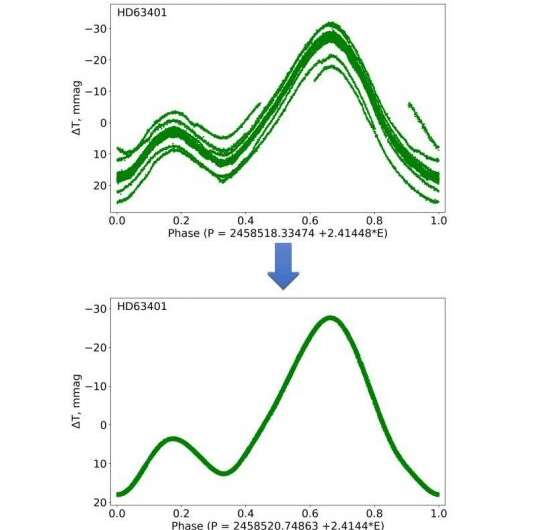March 17, 2020 report
Observations unveil the nature of chemically peculiar star HD 63401

Using NASA's TESS spacecraft and the Canada-France-Hawaii Telescope (CFHT), astronomers from Canada and Ukraine have conducted observations of the magnetic chemically peculiar star HD 63401. Results of the study, presented in a paper published March 5 on the arXiv pre-print server, provide more insights into the puzzling nature of this object.
Chemically peculiar (CP) stars are those with unusual metal abundances, thus exhibiting strong or weak spectral lines for certain elements. Some CP stars are observed to have stronger magnetic fields than classical A- or B-type stars, varying from few tens of Gauss to tens of kiloGauss, and are hence known as magnetic chemically peculiar (mCP) stars (Ap and Bp stars). This class of objects is perceived by astronomers as a natural atomic and magnetic laboratory to study stellar formation and evolution.
HD 63401 is a relatively bright CP star of spectral type B9, known to have significant magnetic field and slow rotation. Observations suggest that the star has a hydrodynamically stable stellar atmosphere showcasing enhanced abundance of silicon (Si), titanium (Ti), chromium (Cr), iron (Fe), and praseodymium (Pr), as well as underabundance of helium (He), oxygen (O) and magnesium (Mg).
Now, a team of astronomers led by Pavlo Kashko of the University of Moncton in Canada, has analyzed the latest photometric and spectroscopic data regarding HD 63401 provided by TESS and CFHT. The new results shed more light on the properties and chemical composition of this star.
"This star has been recently observed with the Transiting Exoplanet Survey Satellite (TESS) (Ricker et al., 2015) that provided short cadence (2 min) photometric measurements. (...) We have performed a spectral analysis of seven high-resolution (R = 65000) and high signal-to-noise ratio Stokes IV spectra recently obtained with the spectropolarimeter ESPaDOnS at the CFHT," the paper reads.
By analyzing the TESS data, the researchers found that the light curve of HD 63401 shows distinct variability typical for Alpha2 Canum Venaticorum variable (α2 CVn) stars. The dataset also allowed the astronomers to derive the rotational period period of HD 63401, which was calculated to be about 2.41 days.
The chemical study of HD 63401 found that its stellar atmosphere showcases a significant underabundance of He, carbon (C), phosphorus (P), vanadium (V), yttrium (Y) and dysprosium (Dy). On the other hand, such chemical elements like sodium (Na), aluminum (Al), Si, Fe, zinc (Zn), and strontium (Sr), turned out to be strongly overabundant in the atmosphere of this star.
The astronomers noted that the detected variability of the light curve and effective temperature of HD 63401, together with the strong overabundance of some chemical elements suggest that abundance patches exist in stellar atmosphere of this star. According to the authors of the paper, this indicates that HD 63401 has a hydrodynamically stable, which was proposed by previous studies.
More information: Revealing the nature of HD 63401, arXiv:2003.02925 [astro-ph.SR] arxiv.org/abs/2003.02925
© 2020 Science X Network





















